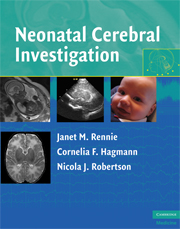Book contents
- Frontmatter
- Contents
- List of contributors
- Preface
- Acknowledgements
- Glossary and abbreviations
- Section I Physics, safety, and patient handling
- 1 Principles of ultrasound
- 2 Principles of EEG
- 3 Principles of magnetic resonance imaging and spectroscopy
- Section II Normal appearances
- Section III Solving clinical problems and interpretation of test results
- Index
- References
3 - Principles of magnetic resonance imaging and spectroscopy
from Section I - Physics, safety, and patient handling
Published online by Cambridge University Press: 07 December 2009
- Frontmatter
- Contents
- List of contributors
- Preface
- Acknowledgements
- Glossary and abbreviations
- Section I Physics, safety, and patient handling
- 1 Principles of ultrasound
- 2 Principles of EEG
- 3 Principles of magnetic resonance imaging and spectroscopy
- Section II Normal appearances
- Section III Solving clinical problems and interpretation of test results
- Index
- References
Summary
Nuclear magnetic resonance – a historical perspective
Magnetic resonance imaging (MRI) is the most important medical diagnostic development since the discovery of X-rays by Roentgen in 1895. Professor Paul Lauterbur obtained the world's first MRI scan in the USA in 1973, but many techniques empowering the modality were invented in the UK at Aberdeen, Nottingham, and Oxford Universities. The main historical highlights are summarized in Fig. 3.1 and Table 3.1.
In 1952 Felix Bloch of Stanford and Edward Purcell of Harvard Universities shared the Nobel Prize for observing nuclear magnetic resonance (NMR) [1, 2] (see below). Following this, the imaging applications of NMR evolved independently of metabolic uses and the terms MRI and magnetic resonance spectroscopy (MRS) came into use (clinical MRI primarily detects hydrogen (1H) nuclei (protons) in water and MRS detects protons and other nuclei in more complicated metabolites).
Magnetic resonance imaging
In 1971 Raymond Damadian showed differences in NMR water characteristics between normal and abnormal tissues as well as between different types of normal tissue [3]. Contemporaneously, Paul Lauterbur superimposed small magnetic field gradients on the highly uniform magnetic field required for NMR spectroscopy: the NMR resonant frequency, of water for example, is directly proportional to the local magnetic field strength and thus location can be encoded. Signal intensity at a particular radio frequency (RF) was then proportional to the water concentration at the corresponding location.
- Type
- Chapter
- Information
- Neonatal Cerebral Investigation , pp. 22 - 44Publisher: Cambridge University PressPrint publication year: 2008



